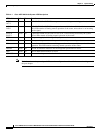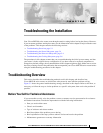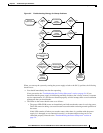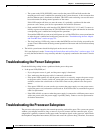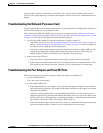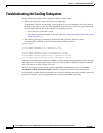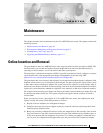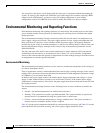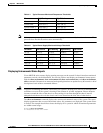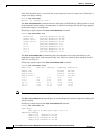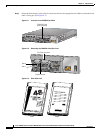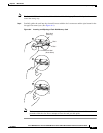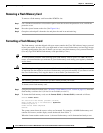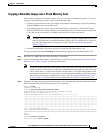
6-2
Cisco uBR7100 Series and Cisco uBR7100E Series Universal Broadband Router Hardware Installation Guide
OL-5916-01
Chapter 6 Maintenance
Environmental Monitoring and Reporting Functions
You can remove and replace a port adapter with the same type of component without interrupting the
system. To replace a port adapter with a different type of port adapter (for example, replacing a HSSI
adapter with an ATM adapter), you must to copy your startup configuration to your running
configuration on the Cisco uBR7100 series router to enable the interfaces on the port adapter.
Environmental Monitoring and Reporting Functions
Environmental monitoring and reporting functions are controlled by the network processor and allow
you to maintain normal system operation by identifying and resolving adverse conditions that might
disrupt operation.
The environmental monitoring functions constantly monitor the internal chassis air temperature and
power supply voltages and currents. The power supply monitors its own voltage and temperature and
shuts itself down if it detects a critical condition within the power supply. The reporting functions
periodically log the values of measured parameters so that you can retrieve them for analysis later, and
the reporting functions display warnings on the console if any of the monitored parameters exceed
defined thresholds.
The front and back of the chassis must remain unobstructed to ensure adequate airflow and prevent
overheating inside the chassis; we recommend at least 3 inches (7.6 cm) of clearance. Temperature
sensors in the router monitor the internal air temperature and send warning messages when the internal
air temperature exceeds the specified threshold.
Environmental Monitoring
The environmental monitoring functions use four sensors to monitor the temperature of the cooling air
as it moves through the chassis.
If the air temperature exceeds a defined threshold, the router displays warning messages on the console
terminal. The system stores the present parameter measurements for both temperature and power voltage
in NVRAM so you can retrieve them later.
In addition, the power supply monitors the internal power supply temperature and voltages. A power
supply is either within tolerance (normal) or out of tolerance (critical). If the internal power supply
temperature or voltage reaches a critical level, the power supply shuts down without any interaction with
the system processor.
The environmental monitoring functions use the following levels of status conditions to monitor the
system:
• Normal—All monitored parameters are within normal tolerances.
• Warning—The system has exceeded a specified threshold. The system continues to operate, but
operator action is recommended to bring the system back to a normal state.
• Critical—An out-of-tolerance temperature or voltage condition exists. The system continues to
operate; however, immediate operator action is required.
Table 6-1 lists the typical temperature thresholds for each network processor type, and Table 6-2 lists the
power thresholds for the normal, warning, and critical (power supply-monitored) levels.



